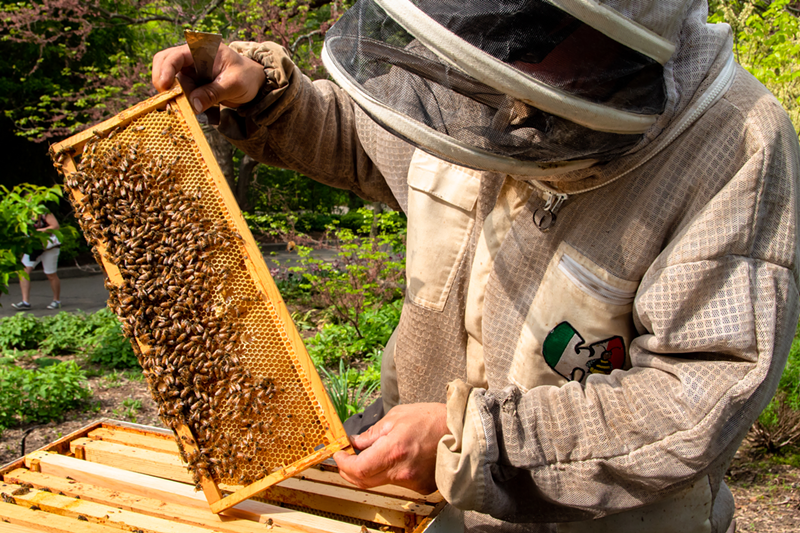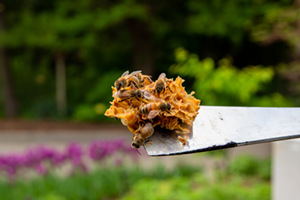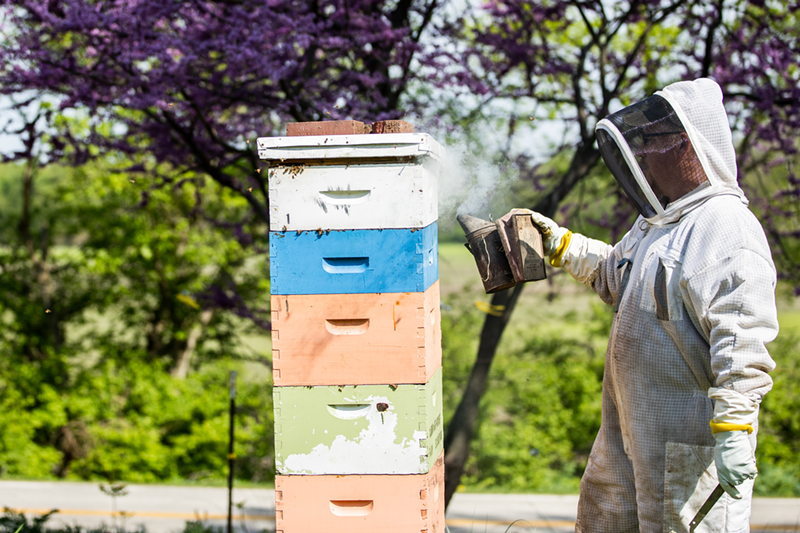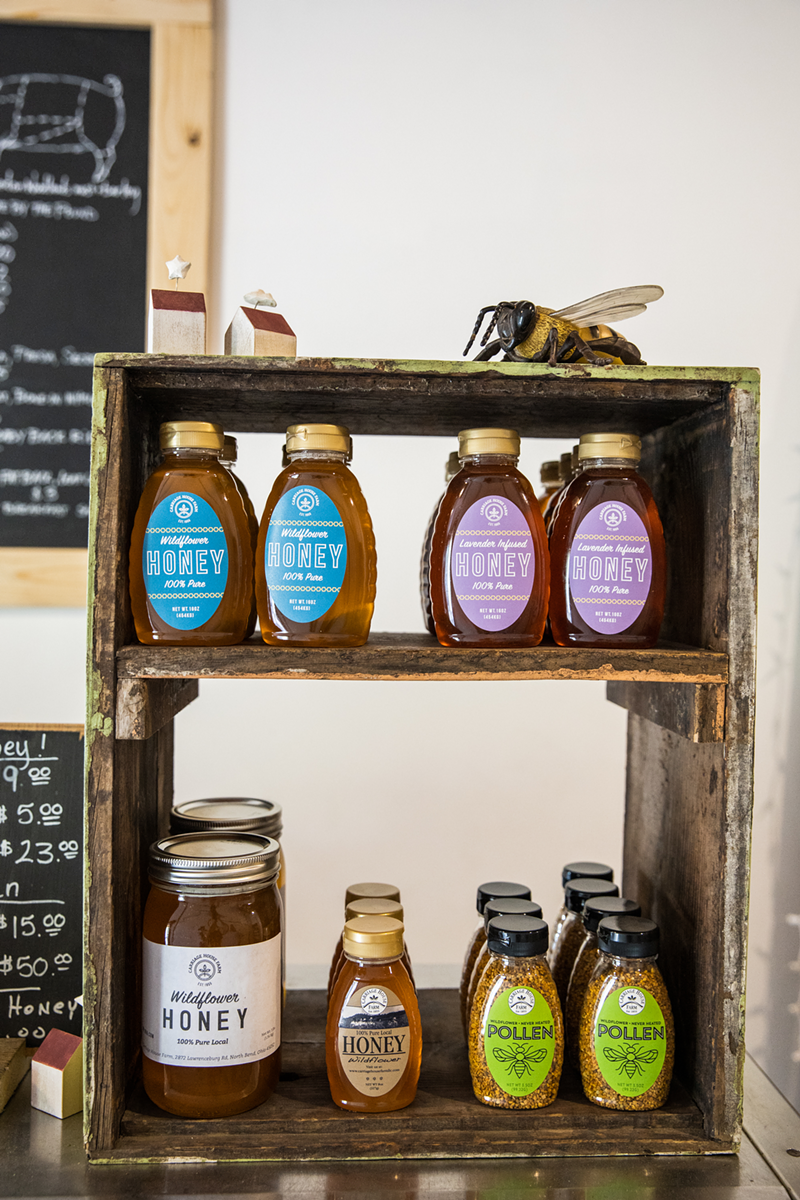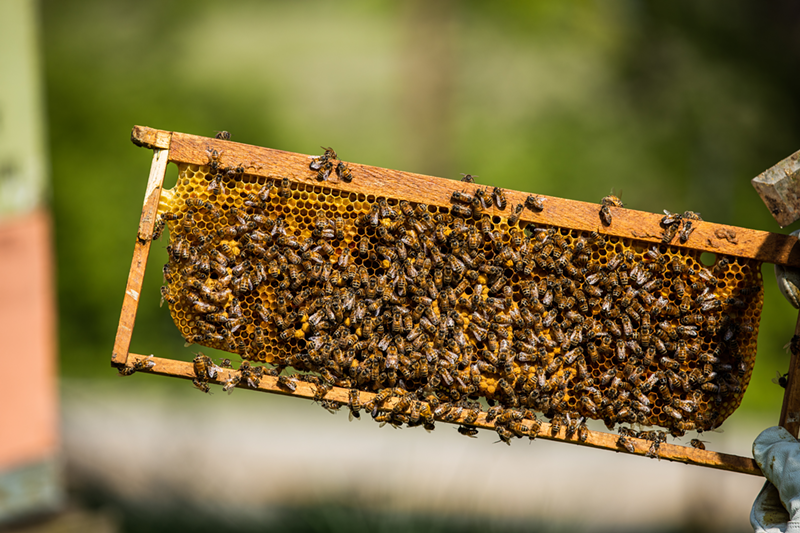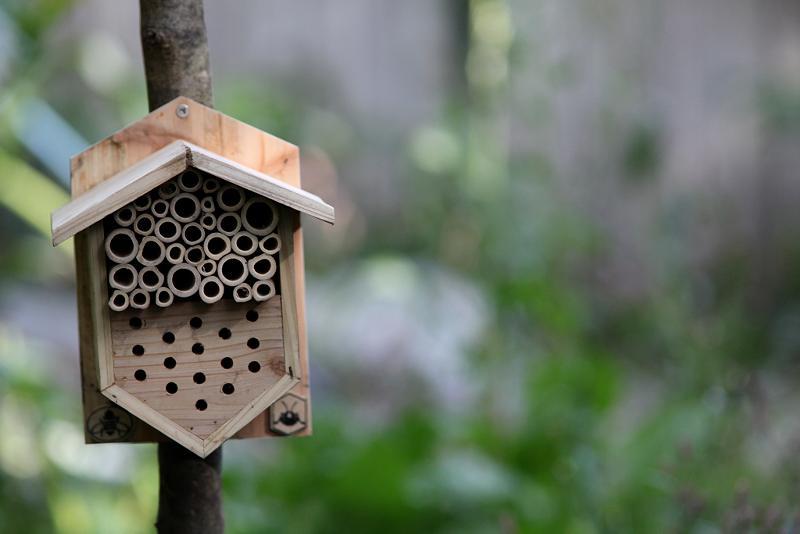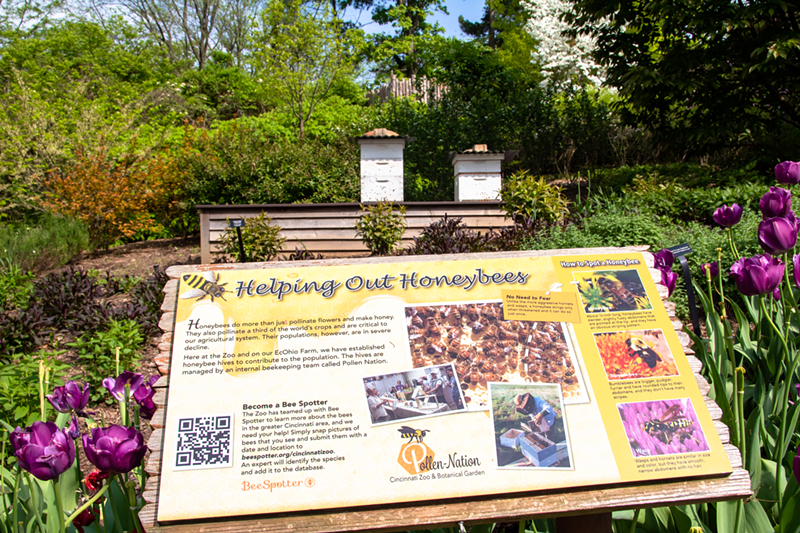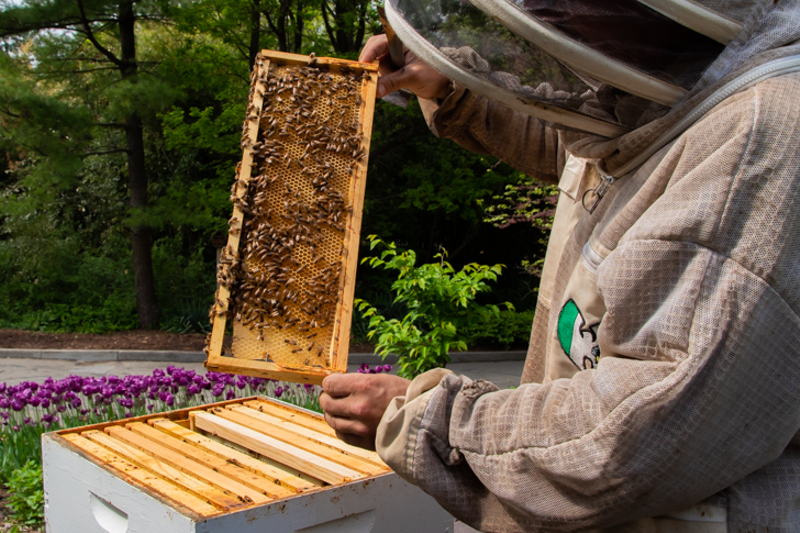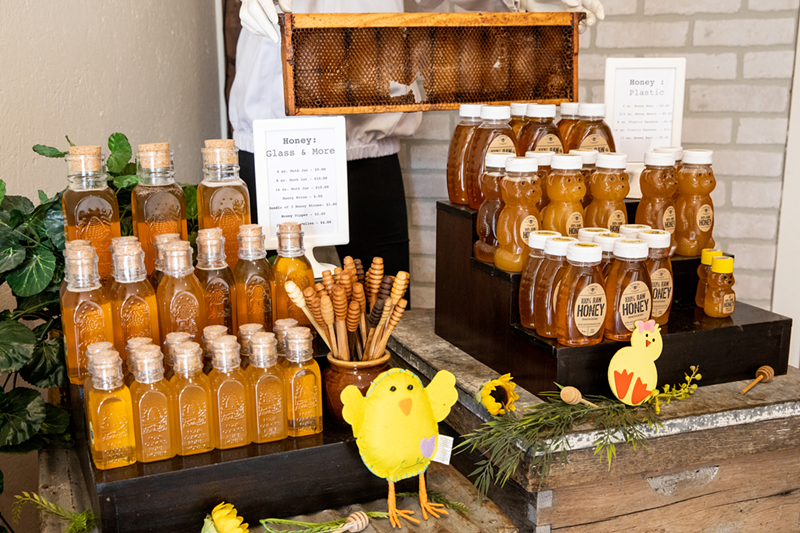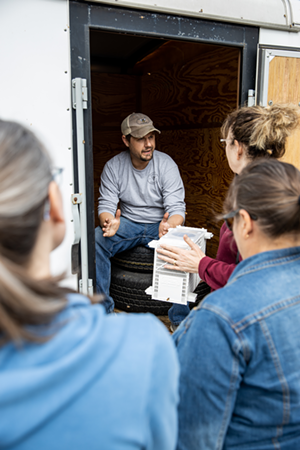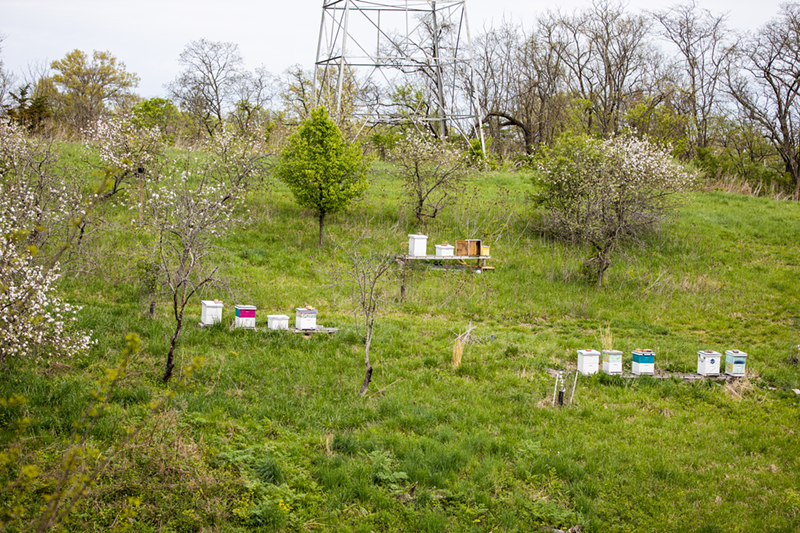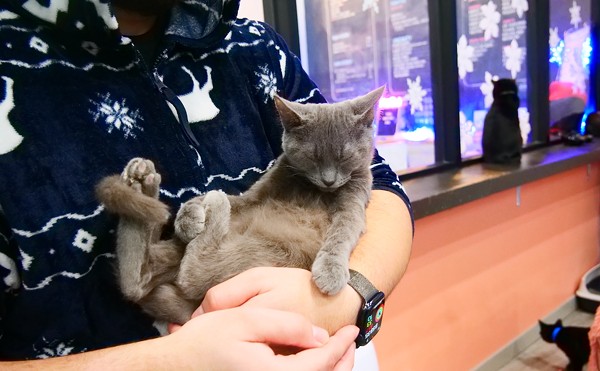It’s mid-afternoon at the Cincinnati Zoo & Botanical Garden. Tucked within a garden bed, lush with blooming foliage, sit two beehives — one was recently donated. Horticulturist Adam Martinez lifts a frame from the larger hive, revealing buzzing honey bees milling about their home.
In one corner, a cluster of five huddle together as if hatching a plot or catching up on the latest gossip.
“That’s basically a larva that fell out of a cell and they’re probably trying to feed it,” Martinez says.
Other bees meander in and out of the space; the sun is warm and birds sing in the distance. “These are happy bees,” he says.
Martinez is wearing a “breezy” suit and veil, both of which protect beekeepers from possible stings. He laughs, pointing to a Wu-Tang Killa Bees patch sewn onto the suit. “My brother gave that to me when I first started beekeeping. He said, ‘Throw that on your jacket.’ Damn, right I did.”
Along with a small group of volunteers, Martinez oversees the hives not only at the zoo but also at its off-grounds Bowyer Farm in Warren County; the farm spans over 600 acres and includes reclaimed wetland habitat.
The delicate art of beekeeping, also known as apiculture, has a long and storied history. For thousands of years, Ancient Egyptians made hives using pipes formed from clay. They would move the hives up and down the Nile River, letting the bees pollinate whatever flowers were in season. Similar practices can be traced back to Ancient China. And Greater Cincinnati can also claim a stake in the history of apiculture: The inventor of the modern beehive, Lorenzo Langstroth, moved to nearby Oxford, Ohio in 1858.
Gene Kritsky, an entomologist, beekeeper and the dean of behavioral and natural sciences at Mount St. Joseph University, explains that Langstroth discovered the “bee space” in 1851.
Bees collect a red-brown resin called “propolis” from tree buds. Known as “bee glue,” the antimicrobial substance is used to patch up parts of the hive and, subsequently, cause man-made hive lids to stick to their frames; the frames are the part of the hive that hold the honeycomb and bee brood (eggs, larvae and pupae).
“Langstroth was trying to figure out a way of taking that lid off without having it get stuck,” Kritsky says.
Enter the bee space: Langstroth discovered that bees would not build a honeycomb in a 1-centimeter space. If the gap was larger (over ⅜ of an inch), they’d build a honeycomb. If it was smaller (under ¼ of an inch), they’d seal it with propolis.
He then incorporated this concept into a top-opening hive, which allowed him to lift the coverboard and access the frames within.
“What that did was dramatic,” Kritsky says. “Instead of having a box that made maybe 20 pounds of honey, you could make 100 pounds of honey. It took it from a hobbyist thing to an almost industrial thing.”
While in Oxford, Langstroth would go on to patent his moveable frames and top-opening hives. You can still stroll by his one-time cottage home on Miami University’s campus, where he would garden and beekeep in the backyard.
Another historical Cincinnati bee aficionado is Charles F. Muth, who started his own grocery business in Cincinnati in 1858. With that money, he began another business selling beekeeping supplies. He was the first person to make jars specifically for honey. Called “Muth Jars,” they are square, made of glass and embossed with beekeeping imagery, such as a hive surrounded by wildflowers.
He also improved other products, like the smoker, which is used to generate smoke and, in effect, calm bees. (The scent masks alarm pheromones, which are released by guard bees if they feel threatened or are hurt.)
Many of these innovations are still used today — Langstroth’s hive remains the standard among modern keepers. Though not as commonplace, Muth Jars can still be bought today and served as inspiration for later honey containers.
Kritsky’s own history with apiculture goes back to when he was 14 and living in Miami, Florida. After picking up larva and pupa from a fallen honeycomb, he brought the items to class for show and tell. His teacher put his frame of bees in their classroom window. Kritsky recalls fellow students watching the bees come and go from their home. He’s been living the beekeeper life ever since.
The thriving culture of old-fashioned beekeeping is still alive in Cincinnati today — every keeper has their own motivations and methods behind the work. In a time where bees and their decreasing populations have become an icon for conservation movements — even PornHub is spearheading a #savethebees campaign — why is apiculture so important? Why do bees need “saving?” And what does modern beekeeping look like?
The Secret Life of Bees
Samantha Gordon of Bee Haven, a local honey and beeswax product boutique, and Richard Stewart, manager of North Bend’s Carriage House Farm, fell into beekeeping and passionately pursue the practice as both a business and a way to promote the biological success of the pollinators.
Gordon bought two hives in 2005 with her mother after her grandmother died; Gordon was her grandmother’s caretaker.
“I just felt like, now what do I do?” Gordon says. The pair bought the hives initially as a new hobby.
“We had no idea what we were doing at all. I had never been in a beehive,” she says. “So we got the book Beekeeping For Dummies and brought it back on the field with us. It was kind of self-teaching.”
But she credits another book, which she read before ’05, with sparking her passion: Sue Monk Kidd’s classic coming-of-age novel The Secret Life of Bees.
Those first two hives did well enough that the following year they were able to keep four. With that addition, they extracted enough honey to sell at the Northside Farmers Market. Fast-forward to present day and Gordon has a full-fledged business, which she runs with her husband Scott. Bee Haven has a brick-and-mortar storefront in Northside and a booth in Over-the-Rhine’s Findlay Market.
Stewart of Carriage House Farm also fell into beekeeping by happenstance. The farm goes back five generations, but it wasn’t until the late ’90s that it went from subsistence to commercial. Stewart gives credit to his dad for that move, who made the change after an early retirement. When Stewart lost his job as a package designer in 2002, he followed in his dad’s footsteps. And by 2005, he started beekeeping.
“As far as the farm is concerned, the bees are just the diversification of everything that we’re doing down here,” he says. “When I started beekeeping, we were doing commodity crops, horse boarding and we had just started our garden. We have enough native pollinators around because we spray so little on this farm, so we’d probably do well even if we didn’t have the honey bees here.”
On the farm, Stewart slips on his suit, gloves and veil, smoker in hand. It’s overcast and the bees, as a result, are more frenzied. They hover outside the colorful hive — which stands fives boxes tall, opens from the top and is stamped with the farm’s name.
“We use foundationless hives,” he says, lifting a wood frame. A foundationless hive means there is no pressed beeswax inside to provide structure for the bees as they build the interior. These bees have already started drawing out their own natural honeycomb shapes.
“We have small little guides to keep it straight, but sometimes they’ll build it willy-nilly,” he explains, tracing the hexagons with his finger. “They just get to a point where they’ll fill it up all the way (with honeycomb).”
The zoo’s Martinez uses a different system, preferring instead to use frames with foundation. Tin roofs held in place by rocks sit atop his hives, creating an overhang that keeps water from trickling inside.
Carriage House’s Stewart points to one bee perched on the frame. On its hind legs is “gorgeous” maroon pollen, picked up from a recent trip. Along with another beekeeper, Brandon Reynolds, they check the hives weekly (as is the norm). There are four bee yards in total: in the garden, behind their main barn, down the road at Carriage House’s Sustainable Ag Site and at the nearby Weber Family Farm. Since the hives are in the same general area, Carriage House only sells wildflower honey; they can’t control what their bees are foraging on. (They also sell honey infused with organic lavender.)
But Bee Haven’s Gordon has hives scattered throughout the region, meaning that her honey yield is more diverse. One hive is stationed in her backyard in Spring Grove Village, three others are nestled along her street and a few others call Northside and North Avondale home. There are also “country” bees on a farm in Clermont County. Honey types include the light-yellow spring honey, golden wildflower and a darker amber buckwheat variant.
“We get that whole experience of what honey is,” Gordon says. “People come up all the time and say, ‘Do you just have regular honey?’ And we’re like, it’s still regular honey, it’s just from different flowers. And so it’s fun to teach them that.”
All of their products are raw and unpasteurized. Aside from honey, they also sell beeswax products — carved candles, hand salves, lotions and lanterns.
With beekeeping, she admits that diving in was a steep learning curve. She still makes mistakes, but that’s all a part of the process.
Carriage House’s Reynolds — on his third year with the farm — would say the same. His first year, he lost colonies. (They even nicknamed him the “Killer Bee”). Now they keep more bees than the year prior. In part, he built populations back up by collecting swarms.
Of that, Stewart explains that bees want to do two things: collect food and divide. When the population of the hive expands, bees will “swarm,” meaning that a single colony will split into two.
Before that happens, worker bees will draw out a new peanut-shaped queen cell — which they then fill with royal jelly to feed her.
“The old queen will move off with almost exactly half the hive. They’ll fly out, land on a tree within 30 feet from the hive, orient and they send out scouts to find a place,” Stewart says. “If they can’t find a place, they move on anywhere from a quarter to a mile away. It’s fascinating. You want diverse genetics, so the bees are programmed to get out of that zone of reproduction.”
You may have witnessed a swarm before: Some 6,000 bees form a cloud nearly 100 feet across and take to the skies. When the queen gets tired, she’ll land and the rest of the hive will cluster over her in an act of protection. Within one minute, that dark buzzing mass will compress to the size of a football. And if you happen to see one, Carriage House will come collect the swarm free of charge.
Other local businesses — like Gaiser Bee Co. and Two Honeys Bee Co. — will also safely collect swarms.
To control to formation of swarms, Stewart says he and Reynolds will split the hives themselves. Two frames will become a new hive, and so on. But, aside from honey, what’s in it for them?
“Seeing bees tirelessly working together to achieve — they’re a super organism. Seeing the synergy is just so crazy,” Reynolds says. “Putting the well-being of the overall system not even ahead of your own, but in line with your own. You wanting the success of everybody makes you feel more in tune with yourself. Every time I open up a hive, it’s a repetition of that example.”
The process is a spiritual one for Gordon, who says it grounds her. “When you go into the bees, you have to stay very calm and slow down. It’s a good, healthy thing for me,” she says. “If you’re flailing or excited, they pick up your energy and it’s good for me to take a step back and focus on the task at hand.”
Hive Intruders
Regardless of the reason they got into beekeeping, beekeepers have a handful of issues to look out for in their respective hives that can cause damage or total loss. According to an annual report by Bee Informed Partnership, the average honey bee colony loss from April 2017 to April 2018 in Ohio was 59.8 percent. And according to the Environmental Protection Agency, the decline of pollinators and the general declining healthy of honey bees may be related a handful of complex and interconnected stressors including pests, pathogens and viruses; poor nutrition due to loss of habitat; exposure to pesticides; long migration routes; and lack of genetic diversity. Beekeepers, even hobbyists, need to look out for all of these.
“It’s harder to keep bees. We ourselves have never witnessed colony collapse disorder,” Stewart says, referring to the buzzword phenomenon of when worker bees inexplicably leaving their queen — and bounds of honey — behind. “It’s always been something that’s well-defined (that has caused our problems).”
One of those issues are hive beetles and varroa mites, a parasite known for attacking honeybee colonies. Gordon and the zoo’s Martinez both cited the mites as an issue as well.
“We don’t use anything to treat — organic or conventional,” Stewart says of warding off the mites. “For the simple fact that we look at it as being a crutch. If you keep treating your bees, you’ll always have bees that need to be treated.”
Mount St. Joseph’s Kritsky points to increasing temperatures as another cause of colony loss. When he first came to the university in 1983, he had a student do a pollen chart to see what flowers the bees were collecting from. Now, the flowers they were getting pollen from in May are blooming in April.
“We’re warmer sooner,” he says. “Second, we’re used to a massive goldenrod nectar flow. We had a pretty good one last year but for a few years the dry summers and the increasing average temperatures have reduced our average (flow).”
He also points out that because of these changes bees are active sooner. And since bees store honey in their hive to last them through winter as a food source, earlier seasons can mean less stockpile before winter hits. (To ensure their hives last through winter, keepers must leave enough honey behind to sustain the colony.)
All of these factors combined have led to things like the #savethebees movement. But if you aren’t ready to jump into a beekeeper suit and veil, there are other ways the public can help protect pollinators.
Going Native
Yes, keeping bees can prove more difficult a task than it was in the past. And the issue goes beyond honey bees — which were actually first imported to the Americas from Europe in the 1600s. Contrary to popular belief, these European honey bees aren’t endangered.
That being said, native bees have seen a decline in population; there are over 4,000 species of bees native to North America. Of those, 500 can be found in Ohio.
As laid out in a New York Times article titled “The Insect Apocalypse is Here,” native pollinators in America are dwindling. In the past 20 years, the rusty-patched bumblebee, for example, dropped 87 percent. In the same stretch of time, monarch butterfly populations fell by 90 percent. Both of these species are native to the region.
But there are ways Cincinnatians can combat this trend in their own backyards, says Cory Christopher, director of the Center for Conservation at the Cincinnati Nature Center.
On a rainy morning, Christopher walks through the center’s greenhouse, where rows and rows of native plants are currently being propagated. In the back, a cluster of volunteers sow seeds and tend to a handful of plants, from milkweed to black-eyed susan and wild bergamot.
“We're trying to really make sure that we take care of these guys because they're going to be the foundations for what people are buying two years from now,” Christopher says of the plants. “(The plants) probably won't see action until 2021.”
The nursery is part of the CNC’s Native Plant Propagation Program, which has a goal of selling native plants to the general public, along with educating the greater community about their importance. Their plant sale is currently in action — you can buy native species at The Nature Shop (4949 Tealtown Road, Milford, cincynature.org) from 10 a.m.-5 p.m. daily through June 2.
“When I think of bees there are a number of things that we have to teach people about. For example, native bees, in general, are not using crops. So a lot of the crops — especially when you start using insecticides — those things aren't available for native pollinators, including butterflies, bees, flies, beetles,” Christopher says. “And if we really want to support native bees, we need to give them the food that they require, both for themselves and for their babies.”
In short, native plants provide shelter and food for native bees, butterflies, birds and other wildlife. They cultivate habitats in otherwise urban areas and help reduce the growth of invasive species like honeysuckle.
Similarly, the Cincinnati Zoo & Botanical Garden is spearheading a program called Pollen Nation, with the goal of boosting pollinator populations. Their team of horticulturists conduct trials to determine which plants benefit from regional pollinators; they then partner with local garden centers to sell the “Zoo’s Best Plants for Pollinators.”
Other habits Christopher says you can incorporate is what he calls “lazy gardening.” Many insects like to lay their eggs in dead vegetation over winter.
“So if you have brush piles, or if you have dead flower stems, a lot of people in the fall feel like they need to go and clip all those and clean their yard up and have everything looking so wonderful,” he says. “But no. A lot of insects, including bees, need that as habitat for winter.”
Simply put: Plant native and then “you don't have to do that much.”
The center also hosts workshops and classes related to conservation, including one that centers on how to build a bee hotel — a space where solitary bees can nest.
“When I give talks to homeowners, one of the first things I say is that, whether you know it or not, if you have a yard, you’re managing land,” Christopher says. “I think a lot of people are taken aback when they realize that they do have control over this little piece of earth. And I want to help them figure out how to take care of it.”
In his work at the center, he wants people to see, and be a part of, the bigger picture — pollinators are just one part of nature’s overarching web.
Sweet Reward
As the zoo’s Martinez places the frames back in their hive, a small crowd of passersby gather. A kid chirps out, “Bees!” as mom snaps a photo of the hive.
“If I can find the queen — I don’t really go searching for her — I will quickly,” he says. “All I need to do, generally, when I’m doing a queen search is just look for evidence that she’s there. And everything’s there. Because if you have queen issues, you need to do something about it fairly quickly.”
A hive is a complex system, but it’s also a fascinating slice of nature: thousands upon thousands of bees working together to keep their home afloat and each other alive.
He goes into the colonies every 10 to 14 days, and more often in the fall when pests problems increase. (Stewart and Gordon expressed similar methods.)
They can be fairly low-maintenance, Martinez says, but it’s when they really need something that beekeeping switches into full-gear.
Mount St. Joseph’s Kritsky’s advice for supporting honey bees? Buy local honey and, if you’re interested in beekeeping yourself, join the Southwestern Ohio Beekeepers Association.
“There’s nothing like it. When you have the veil on, are working with bees that know you, and you open up the hive, have the smoke from your smoker, and this wonderful sweet smell of honey and beeswax,” he says. “You get to the point where you can bee keep without the gloves, where your movements are almost like tai chi. You are one with your bees. Your peripheral vision is reduced because you have this hood and you can focus. It’s incredibly relaxing. And it’s an industry that goes back to 1851. It’s like going back in time.
“The romance of beekeeping is just incredible.”
To learn more about beekeeping, visit the Southwestern Ohio Beekeepers Association at swohiobeekeepers.com. And check out Carriage House Farm (2872 Lawrenceburg Road, North Bend, carriagehousefarmllc.com) or Bee Haven (Findlay Market and 4037 Hamilton Ave., Northside, beehavenhoney.com) for products and more.
Hive Helpers: Gaiser Bee Co. Wants to Inspire Future Beekeepers
By Jessica Baltzersen
It’s 5:30 a.m. on a recent Wednesday morning. Krystle and Cory Gaiser of the Gaiser Bee Company have just arrived back in Cincinnati with 2.6 million bees in tow. The husband-wife team drove through the night from their supplier in Patterson, Georgia and now they’re back on their suburban West Side farm, where they’ll distribute their haul for their annual bee pickup day.
Their trailer is brimming with 250 packages, each containing 10,500 bees and one queen — enough to start the beekeeping process. Between 150 and 200 experienced and new beekeepers will filter through the farm to pick up their honey bee colonies, which will either replace lost hives or launch new ones. (Beekeeping season in Ohio typically begins at the end of April.)
“Bee pickup day is one of the best days of the year for us. It's almost like Christmas morning for our ‘bee-ple,’ ” Krystle says. “The day is absolutely wonderful with all of the positive attitudes and optimism. We get to witness our community come together on this day and share stories that (are) ultimately helping our planet.”
Outside their trailer, a line trickles out as Cory and Krystle hand out bee packages like ice cream cones to eager neighborhood kids. Rogue bees flutter in and out of the window while Cory talks gregariously to each beekeeper. This passion for spreading knowledge about honey bees is why they started Gaiser Bee Company four years ago. Today, their business seeks not only to educate others, but also create an outlet where community members can buy equipment and exchange techniques and information.
Before moving to Cincinnati seven years ago, the Gaisers lived in Michigan, where they started gardening, composting and keeping chickens at home. It was during this time that they noticed that, despite their best efforts, their garden wasn’t yielding any fruits or vegetables. After research, they contributed the loss to a low number of pollinators. This discovery led them down the rabbit hole of honey bee education.
“The more I learned about the decreasing bee population, the more I felt obligated to tell people. I asked myself: Why isn’t anyone talking about this? You realize through education how important bees are to the environment and we became more passionate about it,” Krystle says.
Gaiser is responding to bee hive colony loss by identifying the problem.
“You can’t fix a problem if you don’t know what the problem is,” Cory says.
He believes a large contributor to bee loss is caused by the epidemic of the varroa mite, a parasite that attacks honey bee colonies.
To help increase bee populations, the Gaisers not only sell bee colonies, but they have also developed the “Host-A-Hive” program — an opportunity for community members to help the Gaisers care for new and rescued hives by contributing to the cost of hive equipment. You can visit your hive at the Gaiser farm apiary anytime and at the end of the season, you get 10 pounds of honey as a thank you.
They also offer beginning beekeeping classes, so you can learn more about keeping your own hive at home, and they sell beekeeping supplies and hive kits on their website. It’s through immersive experiences like these that the surrounding community comes closer to understanding the importance of the honey bee’s delicate impact on the larger ecosystem.
“If you’re going to get into beekeeping, you really have to like doing it,” Krystle says. “Our business comes from our passion for honey bees and sharing what we learn with others that feel the same way.”

